Abstract
Objective
Familial risks of anxiety have been assessed in small case-control studies, usually based on reported, but not medically verified, anxiety in family members; thus the degree of familial clustering of these diseases remains to be established.
Methods
The Multigeneration Register, in which all men (sons) and women (daughters) born in Sweden from 1932 onward are registered together with their parents, was linked to hospital admission data. Standardized incidence ratios (SIRs) were calculated as the ratio of the observed to the expected number of cases of men and women with mothers and/or fathers affected by anxiety, compared with men and women whose mothers and/or fathers were not affected by anxiety.
Results
A total of 55,642 and 57,196 cases of anxiety were recorded in offspring and parents, respectively. The overall significant SIRs among men and women with a mother, father or both parents hospitalized for anxiety varied between 1.90 and 5.10. Maternal transmission of anxiety was slightly higher than paternal and the highest SIRs were found in the youngest age groups and among those with both parents affected by anxiety. The degree of parental transmission of anxiety was similar for both men and women.
Conclusions
This study has provided the first data on age-specific familial clustering of anxiety, based on medically confirmed records. The risks were so high that hereditary factors were considered to be likely to contribute, possibly modified by environmental factors. Age-specific risks tables would be helpful for clinical counseling.

Similar content being viewed by others
References
Almeida-Filho N, Lessa I, Magalhaes L, Araujo MJ, Aquino E, de Jesus Mari J (2007) Co-occurrence patterns of anxiety, depression and alcohol use disorders. Eur Arch Psychiatry Clin Neurosci 257:423–431
Alonso J, Angermeyer MC, Bernert S, Bruffaerts R, Brugha TS, Bryson H, et al. (2004) Prevalence of mental disorders in Europe: results from the European study of the epidemiology of mental disorders (ESEMeD) project. Acta Psychiatr Scand Suppl 420:21–27
Boelen PA, Prigerson HG (2007) The influence of symptoms of prolonged grief disorder, depression, and anxiety on quality of life among bereaved adults: a prospective study. Eur Arch Psychiatry Clin Neurosci 257:444–452
Eley TC, Stevenson J (1999) Exploring the covariation between anxiety and depression symptoms: a genetic analysis of the effects of age and sex. J Child Psychol Psychiatry 40:1273–1282
Goldstein RB, Wickramaratne PJ, Horwath E, Weissman MM (1997) Familial aggregation and phenomenology of ‘early’-onset (at or before age 20 years) panic disorder. Arch Gen Psychiatry 54:271–278
Hemminki K, Li X, Johansson SE, Sundquist K, Sundquist J (2006a) Familial risks of aortic aneurysms among siblings in a nationwide Swedish study. Genet Med 8:43–49
Hemminki K, Sundquist K, Li X (2006b) Familial risks for main neurological diseases in siblings based on hospitalizations in Sweden. Twin Res Hum Genet 9:580–586
Hettema JM, Neale MC, Kendler KS (2001a) A review and meta-analysis of the genetic epidemiology of anxiety disorders. Am J Psychiatry 158:1568–1578
Hettema JM, Prescott CA, Kendler KS (2001b) A population-based twin study of generalized anxiety disorder in men and women. J Nerv Ment Dis 189:413–420
Hettema JM, Prescott CA, Myers JM, Neale MC, Kendler KS (2005) The structure of genetic and environmental risk factors for anxiety disorders in men and women. Arch Gen Psychiatry 62:182–189
Kadri N, Agoub M, El Gnaoui S, Berrada S, Moussaoui D (2007) Prevalence of anxiety disorders: a population-based epidemiological study in metropolitan area of Casablanca, Morocco. Ann Gen Psychiatry 6:6
Lewis G, Bebbington P, Brugha T, Farrell M, Gill B, Jenkins R, et al. (1998) Socioeconomic status, standard of living, and neurotic disorder. Lancet 352:605–609
Lofors J, Ramirez-Leon V, Sundquist K (2006) Neighbourhood income and anxiety: a study based on random samples of the Swedish population. Eur J Public Health 16:633–639
Middeldorp CM, Birley AJ, Cath DC, Gillespie NA, Willemsen G, Statham DJ, et al. (2005) Familial clustering of major depression and anxiety disorders in Australian and Dutch twins and siblings. Twin Res Hum Genet 8:609–615
Mineka S, Oehlberg K (2008) The relevance of recent developments in classical conditioning to understanding the etiology and maintenance of anxiety disorders. Acta Psychol (Amst) 127:567–580
Rende R, Weissman M, Rutter M, Wickramaratne P, Harrington R, Pickles A (1997) Psychiatric disorders in the relatives of depressed probands. II. Familial loading for comorbid non-depressive disorders based upon proband age of onset. J Affect Disord 42:23–28
Rosen M, Hakulinen T (2005) Use of disease registers. In: Ahrens W, Pigeot I (eds) Handbook of epidemiology. Springer-Verlag, Berlin
Rothman KJ, Greenland S (1998) Modern epidemiology, 2nd ed. Lippincott-Raven, Philadelphia
Skre I, Onstad S, Edvardsen J, Torgersen S, Kringlen E (1994) A family study of anxiety disorders: familial transmission and relationship to mood disorder and psychoactive substance use disorder. Acta Psychiatr Scand 90:366–374
Somers JM, Goldner EM, Waraich P, Hsu L (2006) Prevalence and incidence studies of anxiety disorders: a systematic review of the literature. Can J Psychiatry 51:100–113
Statistics Sweden (2005) The Swedish multi generation register (1960–1990): http://www.scb.se/default_2154.asp (In Swedish: registret över totalbefolkningen/RTB).
Sundquist K, Frank G, Sundquist J (2004) Urbanisation and incidence of psychosis and depression: follow-up study of 4.4 million women and men in Sweden. Br J Psychiatry 184:293–298
Sundquist K, Li X, Hemminki K (2006) Familial risk of ischemic and hemorrhagic stroke. a large-scale study of the Swedish population. Stroke 37:1668–1673
The National Board of Health and Welfare (2004) The Swedish hospital discharge register and the cause of death register (1961–2001). http://www.socialstyrelsen.se/en/
Acknowledgments
This work was supported by grants to Drs Kristina and Jan Sundquist from the National Institutes of Health (R01 HD052848-01 A1), the Swedish Research Council (K2005-27X-15428-01A), the Swedish Council for Working Life and Social Research (2006-0386 and 2007-1754), and The Swedish Research Council Formas (2006-4255-6596-99 and 2007-1352). Declaration of interest There are no conflicts of interest.
Author information
Authors and Affiliations
Corresponding author
Rights and permissions
About this article
Cite this article
Li, X., Sundquist, J. & Sundquist, K. Age-specific familial risks of anxiety. Eur Arch Psychiatry Clin Neurosc 258, 441–445 (2008). https://doi.org/10.1007/s00406-008-0817-8
Received:
Accepted:
Published:
Issue Date:
DOI: https://doi.org/10.1007/s00406-008-0817-8



